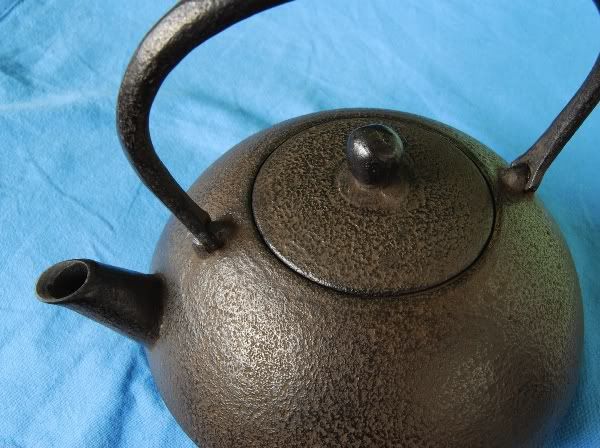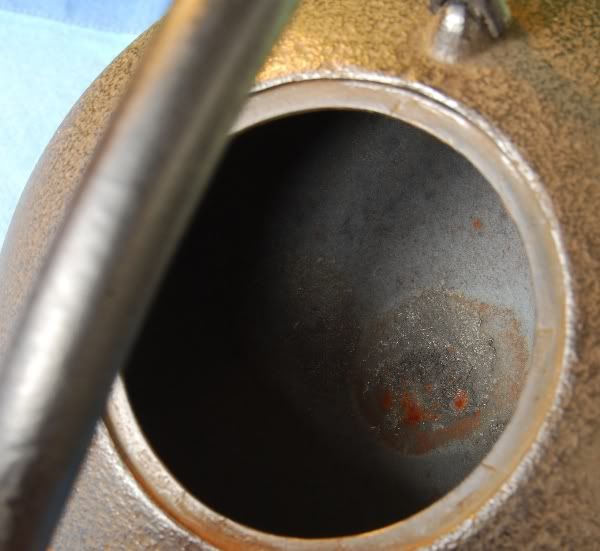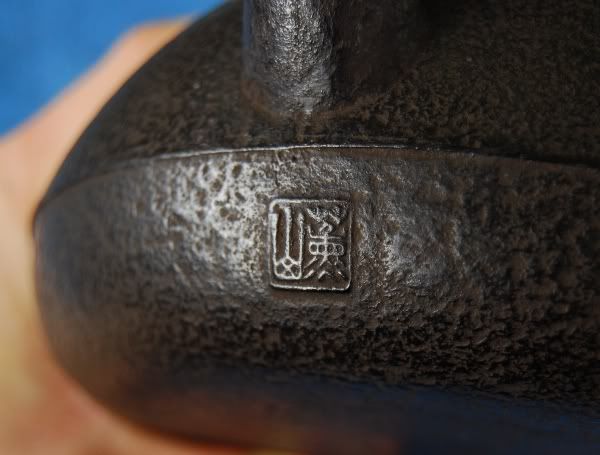Along with the Seigan chawan, another member of our family arrived back in February - this fine example of Nembu-tekki [cast-ironware from Nembu, now called Morioka, in Iwate Prefecture].
This is a tetsubin, for boiling water, rather than being one of ceramic-lined versions used as teapots. (I think I read somewhere that the latter is a modern/foreign practice.)
This is a tetsubin, for boiling water, rather than being one of ceramic-lined versions used as teapots. (I think I read somewhere that the latter is a modern/foreign practice.)
For the last five thousand years, I've used an induction system, which was fine but simply too noisy, with all of its bleeping buttons and noisy fans. We decided to buy a traditional Japanese pot because (i) the producer (Kunzan) has been making them for over a century, and (ii) neither Lei nor I felt that we could trust boiling our water in anything metallic made in the PRC. We figured that with something as important as a water-vessel that we would use every day, it wasn't worth skimping on the money and ending up with some charming PRC-induced malady. As Lei puts it, "I respect Japanese craftsmanship, and it's not likely to kill me."
Pictured above, the bulk of the kettle with a smooth, mottled skin. The alternative is the "hob-nail" effect, in which the skin is punctuated by many triangular stubs. Unsurprisingly, Lei's Chinese aesthetic requires something smooth and pleasant, rather than the "shaqi" [aggressive, pointy, malevolent qi] of a pointy vessel. It will come as no surprise to learn that, as a result of this aesthetic, there aren't many sharp corners in our house or garden. This is fine for me, as I'm extremely clumsy, and tend to bruise myself many times per week on any available pointy furnishings...
Pictured above, the bulk of the kettle with a smooth, mottled skin. The alternative is the "hob-nail" effect, in which the skin is punctuated by many triangular stubs. Unsurprisingly, Lei's Chinese aesthetic requires something smooth and pleasant, rather than the "shaqi" [aggressive, pointy, malevolent qi] of a pointy vessel. It will come as no surprise to learn that, as a result of this aesthetic, there aren't many sharp corners in our house or garden. This is fine for me, as I'm extremely clumsy, and tend to bruise myself many times per week on any available pointy furnishings...
Shown above, the interior of the kettle. Kunzan finish the inner skin with an oxidation layer (a traditional non-chemical, steaming approach) that inhibits rusting. As a result, one mustn't clean the inside - which I believe is generally good advice for all iron kettles, and woks. Cleaning the interior would scrape away the upper layer of the material, and expose plenty of metal for the air to oxidise into rust.
In the centre of the interior, right in the centre of the base, is the mark caused by the finishing process. Little orange spots have formed on it, which the vendor (Artistic Nippon) forewarned us would appear, as part of the normal aging process. They appeared after the second day of use, and have since remained unchanged.
In the centre of the interior, right in the centre of the base, is the mark caused by the finishing process. Little orange spots have formed on it, which the vendor (Artistic Nippon) forewarned us would appear, as part of the normal aging process. They appeared after the second day of use, and have since remained unchanged.
The mark of Kunzan is pictured above. The business has been family-run for a century, with the grandson currently installed as the head kettle-maker, with all manner of accolades from the Japanese Ministry of the Interior.
We're using a hot-plate to warm it up, which makes for a very soothing (and warming!) tea atmosphere, in contrast to the technological cacaphony of the Kamjove inductor. It's gradual and slow, as opposed to the rapidity of the Kamjove, but this has actually turned out to be A Good Thing. I like my tea-sessions to go at a slow pace, and a hurried soul would find it difficult to enjoy much in the way of good tea - at least, that's how it works for me.
I'll post some further experiences with the water and so on in a later article. For now, Kunzan kettles and Artistic Nippon - highly recommended.
We're using a hot-plate to warm it up, which makes for a very soothing (and warming!) tea atmosphere, in contrast to the technological cacaphony of the Kamjove inductor. It's gradual and slow, as opposed to the rapidity of the Kamjove, but this has actually turned out to be A Good Thing. I like my tea-sessions to go at a slow pace, and a hurried soul would find it difficult to enjoy much in the way of good tea - at least, that's how it works for me.
I'll post some further experiences with the water and so on in a later article. For now, Kunzan kettles and Artistic Nippon - highly recommended.




I was just thinking to myself while reading this that this looks just like the kettle I want from Artistic Nippon. Nice Kettle! So the rust colored spots are to be expected huh? One of my concerns is the rust issue and I remain in a should I? or shouldnt I? mode.
ReplyDeleteGorgeous kettle! I would love to get a tetsubin for my water but I'm worried I would ruin it by leaving water in it or not drying it out well enough. It's nice to hear that they don't require too much other maintenance though.
ReplyDeleteBrent
Wow, that's lovely.
ReplyDeleteBeautiful. The spout seems really straight, though. How's the pour.
ReplyDeleteThe boil is *really* slow with a glass kettle and hot plate. I don't mind waiting too much, but I've always heard it's important for the water to come to a boil quickly.
Nice one :). I love my tetsubins. They make great tea, especially with the stuff I normally drink. They also hiss when the water's boiling, which I have come to enjoy.
ReplyDeleteEventually the whole kettle will be orange inside -- it's just a matter of time. Water + iron will become iron oxide, no matter what you do.
I have also tetsubin : one for all teas in my workshop and one for green teas at home and a speciall old one for pu ers. Since I begin to use one, it changes the taste of teas , specially pu ers ( great aroma).It is a good choice ! yours is very nice , all round .
ReplyDeleteI have been looking at getting one of these exact tetsubin for ages.
ReplyDeleteI dont know if its a traditional method, but I have reconditioned several old chagama by gently removing any loose rust etc from the inside and boiling extremely strong tea inside for up to a day.
This develops a reasonably corrosion resistant patina on the inside although you need to boil many changes of fresh water inside before you actually use it to make tea.
@ anonymous : I have only boiled fresh water until the water come very clear and that's all. Now it is great.
ReplyDeleteZounds, it seems I get to the computer exactly once every two days at the moment. Apologies for the late response.
ReplyDeleteBret: grab one. You'll be thrilled. Don't worry about the odd rust spot - it's minor, and entirely inoffensive.
Brent: yes, leaving water in it is a bit of a bind. It's all too easy to forget to empty it! Discipline is required, but I'm still learning it, too, after several months.
CB: worth grabbing one yourself? :)
Will: straight spouted, but seemingly unaffected in terms of function, happily enough. I rather like the simplicity. In terms of water boil, I only brew enough for two infusions at a time, which makes the time taken to boil acceptable. It feels fine. I think boiling a whole kettle-full would be quie some work, though.
MarshalN: the audible tinkles and hisses are a lovely addition to the usual background noise of sleeping cat and ticking clock. I'm with you there.
Gingko: it does work very nicely for pu'er. More on that later!
Anonymous: it's an interesting idea. Perhaps I'll give that a go in the far-flung future... :)
Toodlepip all,
Hobbes
Worth grabbing one? They are so beautiful. I'm sure I'd enjoy it. Having read the very informative section on tetsubins here: http://hojotea.com/categ_e/tetsubin.htm 2 practical considerations emerge, well, 3 actually. First, they are not recommended for use on a gas stove (makes the bottoms rust). Where we live now, no problem, electric range. But we will have a propane stovetop at the new place. Secondly, that source I cited claims "Tetsubin is suitable for green tea, ripe puerh, yellow tea, white tea and flower tea, yet it is not suitable for oolong, young raw pu-erh and black tea. When it is used for the right category of tea, it makes the taste mellower and sweeter. If it is used for the wrong category of tea such as oolong, the flavor becomes flat." I'm curious whether or not you've found this to be true. The 3rd consideration is that the water here already has an abundance of iron in most wells. I have no idea what the well water will be like at the new place (it's in limestone and it flows at a whopping 25 GPM), but the delicious water at our rental house leaves a big rust stain where it drips in the bath tub. It looks completely sparkling clear, and I can just barely taste the iron in it. So adding more iron to it seems superfluous. So, perhaps a ceramic kettle might be a better choice, and there are some really beautiful ones out there. I've been oogling the ones on Matt's Mattcha Blog. For now, the Chantal stainless steel kettle I use at home is a pretty decent solution.
ReplyDeleteI can say without a trace of hesitation that my tetsubin improves my young puerh dramatically, and my aged oolongs too.
ReplyDeleteNow, for the lighter stuff, you might not want this. But that's why you have other kettles.
I'm not entirely sure if I'd buy a new one for $250, but that's because I shop elsewhere and like older things. If you don't want the hassle, it's not a bad bet.
Hi kids,
ReplyDeleteTo keep story short. Cast iron is OK with everythnig but the best vessel to boil water was, is, and always will be Japanese pure silver kettle. Period. kornel